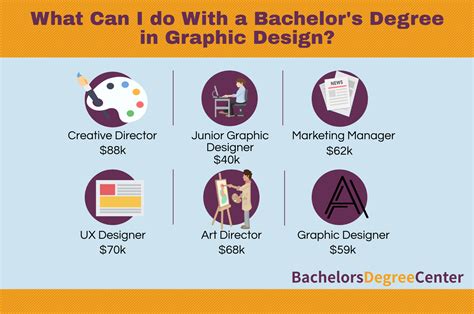In the rapidly evolving digital landscape, graphic designers play a crucial role in shaping visual communication and connecting brands with consumers. With a bachelor’s or master’s degree in graphic design, you’ll possess the skills and knowledge to excel in a wide range of lucrative and fulfilling careers.

In-Demand Job Opportunities
According to the U.S. Bureau of Labor Statistics (BLS), the median annual wage for graphic designers is $56,800. The job outlook is projected to grow by 3% from 2021 to 2031, faster than the average for all occupations.
Here are the top in-demand job opportunities for graphic design graduates:
| Job Title | Median Annual Wage | Projected Job Growth |
|---|---|---|
| Web Designer | $77,200 | 13% |
| Art Director | $104,740 | 4% |
| Creative Director | $129,340 | 2% |
| UI/UX Designer | $93,020 | 10% |
| Brand Identity Designer | $74,240 | 5% |
Specialized Design Roles
In addition to the core job titles, graphic design graduates can explore specialized roles tailored to specific industries or niches:
Industry-Specific Roles:
- Packaging Designer: Focuses on creating eye-catching and functional packaging designs for products.
- Environmental Graphic Designer: Designs signage, murals, and other visual elements for public spaces.
- Exhibition Designer: Plans and executes exhibition displays for museums, trade shows, and other events.
Niche Roles:
- Motion Graphics Designer: Creates animated graphics for websites, videos, and other digital platforms.
- Typography Designer: Designs and styles fonts, lettering, and typography systems.
- Data Visualization Designer: Transforms data into visually compelling and easily understandable formats.
Alternative Applications
Beyond traditional design roles, graphic design skills can be applied to numerous alternative fields:
- User Experience (UX) Design: Enhances the usability and user experience of websites, apps, and other digital products.
- Social Media Marketing: Creates and manages visually appealing content for social media platforms.
- Photography: Uses graphic design principles to enhance and edit photographs for commercial or artistic purposes.
Common Industries for Graphic Designers
Graphic designers find employment in a variety of industries:
| Industry | Percentage of Graphic Designers |
|---|---|
| Advertising and Public Relations | 22% |
| Computer Systems Design | 17% |
| Publishing | 13% |
| Software Development | 8% |
| Manufacturing | 8% |
Effective Strategies for Job Seekers
To increase your chances of securing a high-paying graphic design job, consider the following effective strategies:
- Build a Strong Portfolio: Showcase your best work and demonstrate your versatility in different design styles.
- Network: Attend industry events, join professional organizations, and connect with potential employers on LinkedIn.
- Specialize: Develop a deep understanding of a specific industry or design niche to set yourself apart from competitors.
- Keep Your Skills Up-to-Date: Stay abreast of the latest design tools and software through industry publications and online courses.
- Gain Practical Experience: Participate in internships, freelance projects, or volunteer opportunities to gain real-world experience.
Common Mistakes to Avoid
To avoid common pitfalls in your job search, keep these mistakes in mind:
- Not Marketing Yourself: Don’t underestimate the importance of promoting your skills and experience through online platforms and targeted outreach.
- Lack of Specialization: Avoid being a jack-of-all-trades. Specialize in a particular area to enhance your value as a designer.
- Poor Portfolio Presentation: Your portfolio should be visually appealing, organized, and tailored to the roles you’re applying for.
- Missing Industry Knowledge: Stay informed about industry trends and best practices to demonstrate your commitment to the field.
- Neglecting Soft Skills: While technical skills are crucial, don’t overlook the importance of soft skills such as communication and collaboration.
Conversation-Starting Questions
To engage in meaningful conversations with potential employers and fellow designers, consider these conversation-starting questions:
- “What are the biggest challenges facing graphic designers in today’s industry?”
- “How has technology transformed the role of graphic designers?”
- “Are there any emerging trends or innovations in graphic design that I should be aware of?”
- “What qualities do you value most in a successful graphic designer?”
- “How can I differentiate myself from other candidates in the job market?”
Conclusion
With a graphic design degree, you’re equipped to embark on a rewarding and multifaceted career in visual communication. By honing your skills, specializing in your niche, and staying abreast of industry trends, you can unlock a world of opportunities and achieve your professional goals.
